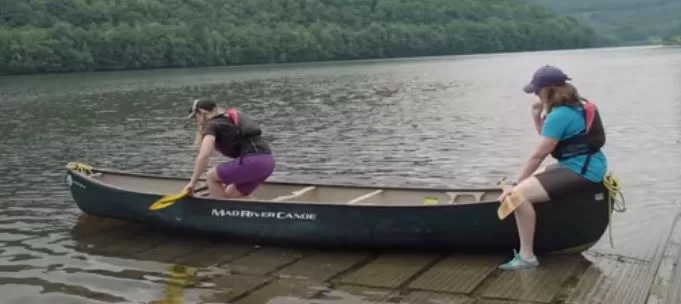Are you prepared to get on the water and go outside? Canoeing is a great exercise for getting fitness, and a activity for enjoying the surroundings, time with loved ones.
Whether you’re a novice or a seasoned paddler, mastering the art of getting into a canoe is essential for a smooth and enjoyable experience on the water.
We’ll go over all of the detacanoe, basic paddling methods, and possible safety measures. We’ll give you all the advice to feel secure on the water. Now that you have your canoe life jacket, let’s begin.
Key Takeaways On How To Get Into Canoe
How to Get into Canoe – To get into a canoe, position it parallel to the dock or shoreline. Squat beside the canoe, grasp the canoe gunwale on both sides and shift your weight over the center line. Place one foot in the canoe, then the other. Maintain a low center of gravity and be cautious.
What To Do If The Canoe Starts To Tip Over When I’m Getting In – If the canoe starts to tip over when you get into it, stay calm and keep your weight low and centered in the boat. If your canoe capsized and you fall out of the canoe, try to stay upstream of the boat and swim to shore or a nearby object you can hold onto until help arrives.
What Safety Precautions To Consider – Some safety precautions to consider when canoeing include wearing a life jacket, checking the weather forecast, knowing the water conditions, and bringing appropriate safety gear. It’s also important to let someone know where you’re going and when you plan to return.
From Shallow Shoreline or Beach
- Position the Canoe perpendicular to the Shore:
Place the canoe parallel to the water’s edge with one end resting on the sand or shore. It is simpler to get in and out of the canoe because of this alignment.
2. Have one person stabilize the canoe:
Have a companion hold onto the canoe to keep it steady while you enter the water to avoid it from drifting or toppling. This guarantees stability and security.

3. Bend Your Knees and Put Your Dominant Leg First:
Face the front in the shallow water beside the canoe. Put your dominant leg in the middle of the boat while keeping your knees slightly bent for stability. You create a strong foundation for balance and control by doing this.
4. Front-Facing Position:
Adjust your body so that it is towards the front once your dominant leg is safely inside the canoe. Throughout the entering process, this posture assists in preserving balance and control.
5. The Person Sitting Will Walk The Canoe Length To Sit At The Other End:
If someone is already seated in the canoe, they should move their weight to the other end so you can enter. This guarantees stability and optimum weight distribution.

6. Slide Your Hands Along The Gunnels For Support:
Slide your hands along the canoe’s gunnels (top edges) as you get further inside for support and stability. You can use this technique to enter the canoe with more control and balance.
7. The Other Person Can Sit on The Opposite End:
The other person can cautiously enter the canoe and take their seat at the opposite end once you are safely seated inside it. The canoe’s stability is maintained by slow entry.
8. Keep The Center of Gravity Low:
Maintain a low center of gravity throughout the process by distributing your weight evenly and avoiding rapid movements. This stability guarantees a safe and satisfying canoeing experience and helps prevent tipping.
For better stability, you should wear best canoeing shoes and equipped with other canoeing accessories to make getting into the water an easy job.
From Deep Shoreline or Dock
- Position the canoe parallel to the dock or shoreline:
The first step is to position the canoe parallel to the dock or shoreline. This will make it easier to get into the canoe without tipping it over. You can push the canoe into the water until it is parallel to the dock or shoreline.

- Squat down on the dock or shoreline beside the canoe:
Once the canoe is in position, squat down on the dock or shoreline beside the canoe. This will help you maintain your balance and make it easier to get into the canoe.
- Hold onto the gunwale on both sides of the canoe:
With one hand on each side of the canoe, hold onto the gunwale (the upper edge of the canoe) on both sides of the canoe. This will help you maintain your balance and keep the canoe steady.

- Lean out to shift your weight over the canoe’s centerline:
Lean out over the canoe to shift your weight over the centerline of the canoe. This will help you maintain your balance and make it easier to get into the canoe.
- Place one foot in the canoe on the centerline:
Once you have shifted your weight over the centerline of the canoe, place one foot in the canoe on the centerline. This will help you maintain your balance and make it easier to get into the canoe.
- Kneel to keep a low center of gravity:
Once you have one foot in the canoe, kneel to keep a low center of gravity. This will help you maintain your balance and keep the canoe steady.
- Move the other foot into the canoe:
Finally, move your other foot into the canoe. Once both feet are in the canoe, you can sit down and get ready to paddle.
Alternatively, if you are entering the canoe from a shoreline, you can place it in the water with its stern touching the bank. Then, hold onto the gunwales on both sides of the stern and step into the canoe.
If you’re a beginner and afraid of capsizing during getting into a canoe, then you can install DIY canoe stabilizers to prevent this risk. Other than that, you should also consider the weight of your canoe, and canoeing materials, because some material like aluminum are good at stability.
What If I’m Canoeing alone?
Getting into a canoe when you’re canoeing alone requires careful technique to ensure safety and stability.

- Choose a stable location:
To launch your canoe, choose a site along the shore that is steady and calm, away from obstructions and locations with strong currents like whitewater canoeing.
- Position the canoe parallel to the shore:
Make sure it’s secure and won’t move while you’re getting in by placing it parallel to the water’s edge.
- Secure your gear:
Before getting in the canoe, put any gear or equipment inside to ensure stability and good weight distribution.
- Step into the canoe’s center:
Face the front while standing in the shallow water next to the canoe. Step into the middle of the canoe with one foot while maintaining a solid grasp on both sides.
- Steady the canoe:
Use your free hand to grip the side or gunwale of the canoe as you step inside for support. This helps keep the canoe from wobbling or toppling over.
- Bring your other leg into the canoe:
Bring your other leg inside the canoe slowly while keeping balance and stability after you have one foot in the center.
- Avoid stepping on the gunwales:
Avoid stepping on the canoe’s upper edges, or gunwales, when climbing in. They may become unstable and more likely to topple if someone steps on them.
- Sit down and adjust your position:
Carefully lower yourself into a seated posture once both legs are inside the canoe. Choose a comfortable position, then change it to distribute your weight evenly.
- Stabilize the canoe:
Once you’re sitting down, use your canoe paddle or your hands to steady it so it’s balanced and not leaning to one side.
Why it Is important to know how to get into the canoe?
Knowing how to get into canoe is an essential part of canoeing, and here are some reasons why it’s important to know how to get into a canoe:
Safety:
It can make canoeing a dangerous activity if you enter a canoe incorrectly since this could cause the boat to tip over. You can avoid accidents and injuries by using the right canoe entry method.
Stability:
When entering and exiting correctly, canoes are intended to be steady. Understanding how to enter a canoe can keep the boat balanced and stable.
Enjoyment:
While canoeing is enjoyable, learning how to enter the boat safely may be challenging. Knowing the right procedure may make getting into the canoe a simple and fun process.
Safety Considerations
To ensure safety when entering a canoe, it is important to take the following precautions:
- Wear Personal Protective Equipment (PPE):
To maintain stability and safety in case of unintentional tipping or going overboard, always wear a canoe life jacket that is correctly fitted.
- Anchor the canoe or hold it steady:
It is good to have someone hold it steady before entering to stop it from rocking or drifting away.
- Check for any damaged or lost parts:
Verify that all of the canoe’s components are well secured and check the canoe for any damage, such as cracks or holes. By doing so, you’ll be able to maintain stability and steer clear of mistakes, whether entering or paddling a canoe.
- Maintain a low and stable center of gravity:
Keep your knees bent and squat down as you get inside the canoe. This promotes stability and balance, especially while getting into the canoe.
- Distribute weight evenly:
To preserve stability, distribute your weight equally when getting into the canoe. Try not to lean too much to one side to prevent the canoe from tipping over.
- Move slowly and cautiously:
Avoid making quick movements that might throw your balance off when getting into the boat. Moving slowly and deliberately promotes stability and reduces accidents.
- Take small steps:
When stepping into the canoe, take small and controlled steps to avoid tipping the canoe. This allows you to maintain balance and adjust your footing as needed.
- Communicate with others:
Coordinate your moves when getting into the boat with others to guarantee everyone’s safety. This aids in avoiding any unintentional accidents or balance interruptions.
- Know how to re-enter the canoe:
Understanding how to enter it securely after an accident tipping it or going overboard is crucial. To be ready for such circumstances, familiarise yourself with re-entry tactics beforehand.
- Push off gently and smoothly:
Once securely in the canoe, push off from the shore or dock gradually and evenly to prevent any rapid movements that might cause the canoe to become unsteady.
What should I do if I start to tip over when I’m getting into a canoe?
If you start to tip over when getting into a canoe, it’s important to stay calm and take immediate action to prevent capsizing. Here’s what you can do:
Stay low: Lower your center of gravity by crouching in the canoe. This helps stabilize the boat and makes it less likely to tip over.
Grab onto the canoe: Hold onto the sides firmly to maintain your balance and prevent further tipping.
Shift your weight: If you feel the canoe tipping to one side, try to shift your weight in the opposite direction to counterbalance it. This can help bring the canoe back to a stable position.
Call for assistance: If you cannot regain stability or feel unsafe, call for help from a nearby boater or canoeing partner. They can assist and help prevent a complete capsize.
How To Re-Enter The Canoe In Case Of Accidental Tipping
First, position yourself and your partner at the canoe’s front (bow) and back (stern). This helps balance the boat and makes it easier to get back in.
Next, use your legs to kick and help propel the canoe back upright. If the water is shallow enough, you can push off the river or lake bottom to flip it over. If water is still inside the canoe, grab a bailer or bucket to remove it before attempting to re-enter.
Once the canoe is upright and empty, approach it from the side and grab onto the sides (gunwales).
Pull yourself onto the canoe, keeping your center of gravity low and stable to maintain balance.
If you’re alone, move towards the back (stern) end of the canoe to help balance it, and then carefully re-enter from there. After successfully re-entering the canoe, take a moment to ensure it is stable and balanced before proceeding.
If you’re canoeing at ocean and want to feel safe then you should also choose canoe width wisely, but since it increases the drag during paddling then it can lower your canoeing speed.
FAQs – How to Get into Canoe
Can I Use A Paddle For Support While Getting Into The Canoe?
The canoe may tip over if you use the paddle as support, which is risky, especially if you are not wearing a life jacket. It is preferable to use the correct method, which involves securing the canoe before entering, setting it parallel to the dock or beach, and cautiously bringing each leg into the canoe while holding onto the side of the boat nearest to you. (Source)
Is Getting Into A Canoe From A Dock Easy?
Yes, it is easy to enter a canoe from a dock if you use the right approach. Squat down next to the canoe, hang on to the gunwale, lean out to move your weight across the centerline, put one foot in the boat, kneel down, and put the other foot in the canoe. Position the canoe parallel to the dock.
Can I Use A Step Stool or a Ladder To Make It Easier to get into the canoe?
Yes, a stool or ladder can be used to get into a canoe on shore. Using a stool or ladder can make it easier to get into the canoe, especially if the shoreline is steep or if you have mobility issues.
However, it’s important to ensure that the stool or ladder is stable and secure before using it to get into the canoe. You should also ensure that the stool or ladder is positioned to allow you to enter the canoe safely and easily. (Source)
Which Leg To Put First In The Canoe?
You can put either leg in first while getting into a canoe. However, it is advised to put one leg towards the boat’s center. If you first place your right leg in, rapidly reach across to the other side of the canoe with your right hand.
If your left leg got in first, use your left hand. Bring the rest of your body into the canoe slowly but fluidly, keeping your center.

Jack Bennett, a passionate pedal boating enthusiast, and marine engineer by day, is here to share my knowledge and love for this exciting sport with you all. Happy Boating!
